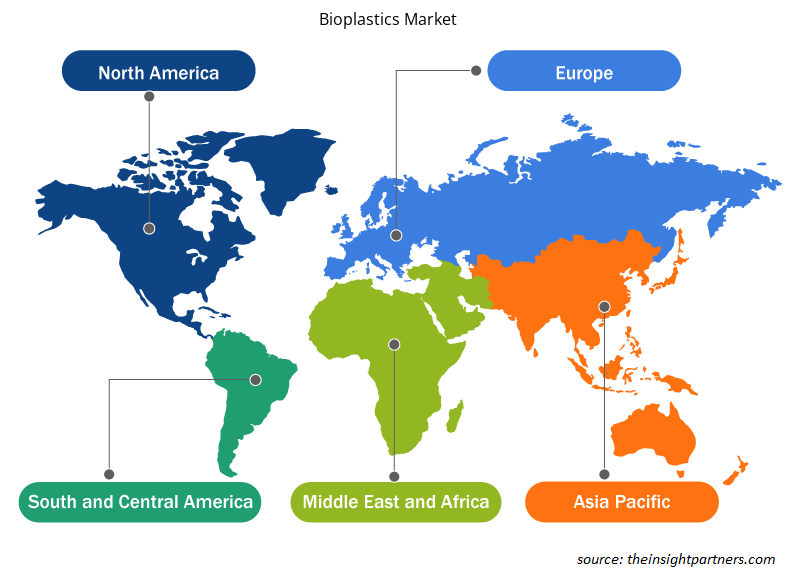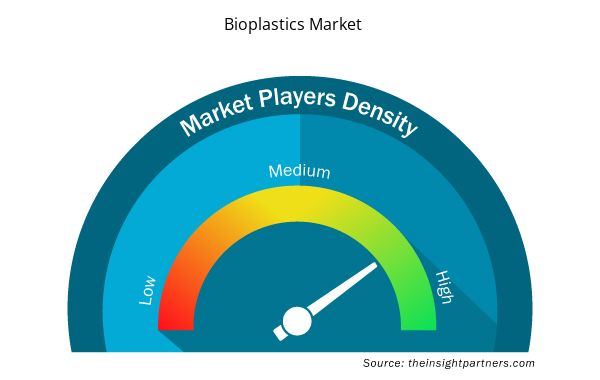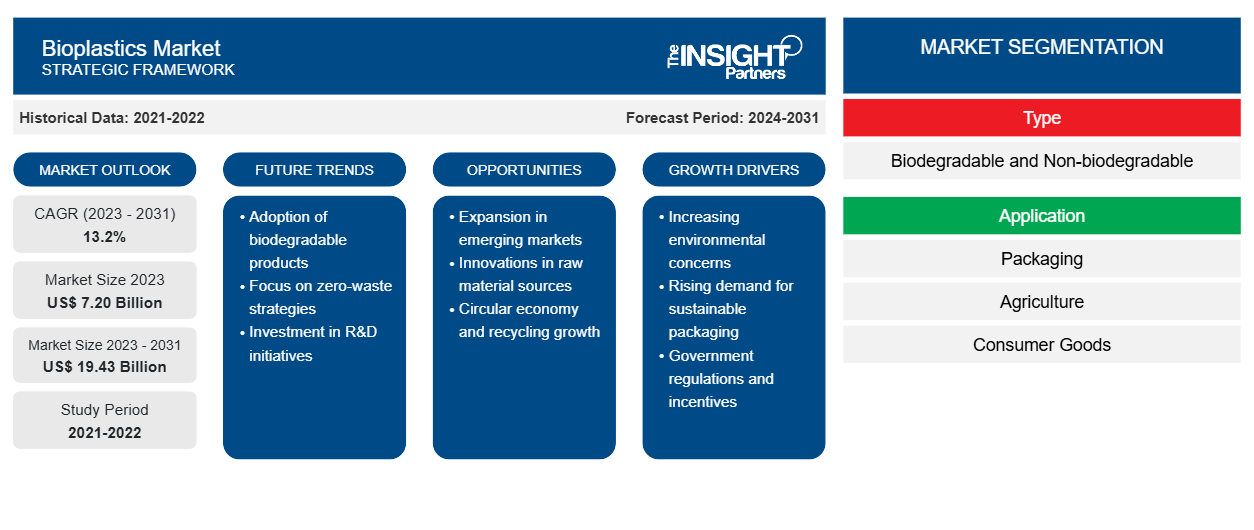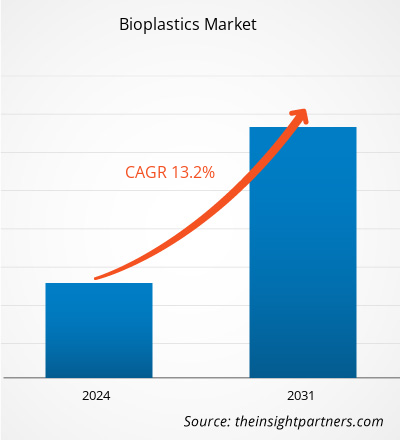Der Markt für Biokunststoffe soll von 7,20 Milliarden US-Dollar im Jahr 2023 auf 19,43 Milliarden US-Dollar im Jahr 2031 anwachsen. Der Markt wird voraussichtlich zwischen 2023 und 2031 eine durchschnittliche jährliche Wachstumsrate (CAGR) von 13,2 % verzeichnen. Der zunehmende Fokus auf Innovation und technologischen Fortschritt dürfte auch weiterhin die wichtigsten Trends auf dem Biokunststoffmarkt bleiben.
Biokunststoffe Marktanalyse
Die wachsenden Umweltbedenken und das globale Bestreben, die Umweltverschmutzung zu verringern, treiben die Nachfrage nach biologisch abbaubaren Kunststoffen im Verpackungssektor weltweit an. Darüber hinaus wird erwartet, dass die Nachfrage nach Biokunststoffen in der Verpackungsindustrie aufgrund des steigenden Bedarfs an verschiedenen Gesundheitsprodukten steigen wird. Darüber hinaus ist es für Hersteller einfach, Verpackungen aus Biokunststoffen herzustellen, da Verpackungen aus Biopolymeren normalerweise mit Standardtechnologie zur Kunststoffverarbeitung hergestellt werden können. Die wachsende Nachfrage nach umweltfreundlichen Kunststoffen im Verpackungssektor ist ein wichtiger Faktor, der das Wachstum des Biokunststoffmarktes weltweit im Prognosezeitraum ankurbeln dürfte.
Marktübersicht für Biokunststoffe
Biokunststoffe sind Kunststoffe, die aus erneuerbaren Biomassequellen bestehen, darunter pflanzliche Fette und Öle, Maisstärke, Stroh, Holzspäne, Sägemehl und recycelte Lebensmittelabfälle. Biokunststoffe werden zunehmend eingesetzt, um das Problem des Plastikmülls zu reduzieren, der den Planeten erstickt und die Umwelt verschmutzt . Darüber hinaus erfordert die Herstellung von Biokunststoffen 65 % weniger Energie als herkömmliche Erdölkunststoffe.
Passen Sie diesen Bericht Ihren Anforderungen an
Sie erhalten kostenlose Anpassungen an jedem Bericht, einschließlich Teilen dieses Berichts oder einer Analyse auf Länderebene, eines Excel-Datenpakets sowie tolle Angebote und Rabatte für Start-ups und Universitäten.
- Holen Sie sich die wichtigsten Markttrends aus diesem Bericht.Dieses KOSTENLOSE Beispiel umfasst eine Datenanalyse von Markttrends bis hin zu Schätzungen und Prognosen.
Treiber und Chancen auf dem Biokunststoffmarkt
Steigende Nachfrage nach Biokunststoffen in verschiedenen Anwendungsbereichen
Die steigende Nachfrage nach Biokunststoffen in verschiedenen Anwendungsbereichen ist ein wichtiger Treiber für den Biokunststoffmarkt. Biokunststoffe werden in zahlreichen Endverbrauchsbranchen wie Medizin, Automobil und Transport, Verpackung, Landwirtschaft, Konsumgüter, Textilien, Bauwesen und anderen eingesetzt. Im medizinischen Bereich finden Biokunststoffe umfassende Anwendung in der Wundversorgung, Gewebezüchtung, Arzneimittelverabreichung, orthopädischen Geräten und der Herstellung von faserigen und porösen Gerüsten. Im Automobilbereich sorgen Biokunststoffe für eine geringere Abhängigkeit von fossilen Ressourcen, geringere Herstellungskosten und einen deutlich geringeren CO2-Fußabdruck. Darüber hinaus werden Biokunststoffe für die starre Verpackung von Kosmetika wie Kompaktpuder, Cremes, Lippenstiften und Getränkeflaschen verwendet .
Strenge staatliche Gesetze und Vorschriften zur Verwendung herkömmlicher Kunststoffe
Zahlreiche Länder auf der ganzen Welt haben Gesetze und Vorschriften zum Thema Kunststoff erlassen. Verschiedene Länder unternehmen Anstrengungen, um Einwegkunststoffe zu verbieten und nachhaltige Alternativen zu fördern. Dies wird dazu beitragen, die negativen Auswirkungen auf das menschliche Leben und die Umwelt zu mildern. Daher ist zu erwarten, dass die strengen staatlichen Gesetze und Vorschriften zur Verwendung herkömmlicher Kunststoffe lukrativere Möglichkeiten für das Wachstum des Biokunststoffmarktes bieten.
Segmentierungsanalyse des Biokunststoffmarktberichts
Schlüsselsegmente, die zur Ableitung der Biokunststoffmarktanalyse beigetragen haben, sind Typ und Anwendung.
- Je nach Typ ist der Markt in biologisch abbaubar und nicht biologisch abbaubar unterteilt. Das biologisch abbaubare Segment hatte im Jahr 2023 einen größeren Marktanteil.
- Nach Anwendung ist der Markt in Verpackung, Landwirtschaft, Konsumgüter, Automobil und Transport, Textilien, Bauwesen und andere unterteilt. Das Verpackungssegment hielt im Jahr 2023 den größten Marktanteil.
Biokunststoffe Marktanteilsanalyse nach Geografie
Der geografische Umfang des Biokunststoffmarktberichts ist hauptsächlich in fünf Regionen unterteilt: Nordamerika, Asien-Pazifik, Europa, Naher Osten und Afrika sowie Süd- und Mittelamerika.
Der globale Markt wurde von Asien-Pazifik dominiert. Europa ist ein zweiter großer Anteilseigner des globalen Biokunststoffmarktes. In Nordamerika werden Biokunststoffe in der Verpackungsbranche in Form von Plastikflaschen und -tüten häufig verwendet. Produktion und Verbrauch von Biokunststoffen werden in der Region voraussichtlich wachsen, vor allem bei Lebensmittelverpackungen. Im Gegensatz zu herkömmlichen Kunststoffen werden Biokunststoffe aus erneuerbaren Quellen gewonnen. Die Automobilindustrie in dieser Region ist aufgrund erheblicher Investitionen in Infrastruktur, F&E-Aktivitäten und neue Produktionsanlagen eine der fortschrittlichsten Branchen weltweit. Biopolyamide (Bio-PA), Polymilchsäure (PLA) und biobasiertes Polypropylen (Bio-PP) sind Biokunststoffe, die im Automobilbau häufig verwendet werden. Diese Faktoren treiben das Wachstum des Marktes für Biokunststoffe im Automobilbereich voran.
Regionale Einblicke in den Biokunststoffmarkt
Die regionalen Trends und Faktoren, die den Biokunststoffmarkt im Prognosezeitraum beeinflussen, wurden von den Analysten von Insight Partners ausführlich erläutert. In diesem Abschnitt werden auch die Marktsegmente und die geografische Lage des Biokunststoffmarkts in Nordamerika, Europa, im asiatisch-pazifischen Raum, im Nahen Osten und Afrika sowie in Süd- und Mittelamerika erörtert.

- Holen Sie sich die regionalen Daten für den Biokunststoffmarkt
Umfang des Marktberichts über Biokunststoffe
| Berichtsattribut | Details |
|---|---|
| Marktgröße im Jahr 2023 | 7,20 Milliarden US-Dollar |
| Marktgröße bis 2031 | 19,43 Milliarden US-Dollar |
| Globale CAGR (2023 - 2031) | 13,2 % |
| Historische Daten | 2021-2022 |
| Prognosezeitraum | 2024–2031 |
| Abgedeckte Segmente | Nach Typ
|
| Abgedeckte Regionen und Länder | Nordamerika
|
| Marktführer und wichtige Unternehmensprofile |
|
Marktdichte von Biokunststoffen: Auswirkungen auf die Geschäftsdynamik
Der Markt für Biokunststoffe wächst rasant, angetrieben durch die steigende Nachfrage der Endverbraucher aufgrund von Faktoren wie sich entwickelnden Verbraucherpräferenzen, technologischen Fortschritten und einem größeren Bewusstsein für die Vorteile des Produkts. Mit der steigenden Nachfrage erweitern Unternehmen ihr Angebot, entwickeln Innovationen, um die Bedürfnisse der Verbraucher zu erfüllen, und nutzen neue Trends, was das Marktwachstum weiter ankurbelt.
Die Marktteilnehmerdichte bezieht sich auf die Verteilung von Firmen oder Unternehmen, die in einem bestimmten Markt oder einer bestimmten Branche tätig sind. Sie gibt an, wie viele Wettbewerber (Marktteilnehmer) in einem bestimmten Marktraum im Verhältnis zu seiner Größe oder seinem gesamten Marktwert präsent sind.
Die wichtigsten auf dem Biokunststoffmarkt tätigen Unternehmen sind:
- Teijin Limited
- Toray Industries, Inc.
- Sabic
- BASF SE
- Gesamtcorbion PLA
- Braskem SA
Haftungsausschluss : Die oben aufgeführten Unternehmen sind nicht in einer bestimmten Reihenfolge aufgeführt.

- Überblick über die wichtigsten Akteure auf dem Biokunststoffmarkt
Neuigkeiten und aktuelle Entwicklungen zum Biokunststoffmarkt
Der Biokunststoffmarkt wird durch die Erhebung qualitativer und quantitativer Daten nach Primär- und Sekundärforschung bewertet, die wichtige Unternehmensveröffentlichungen, Verbandsdaten und Datenbanken umfasst. Im Folgenden finden Sie eine Liste der Entwicklungen auf dem Markt für Sprach- und Sprechstörungen sowie Strategien:
- SABIC, ein weltweit führendes Unternehmen der chemischen Industrie, hat heute ein neues Portfolio biobasierter ULTEM™-Harze auf den Markt gebracht, die Nachhaltigkeitsvorteile bieten und gleichzeitig genau die gleiche hohe Leistung und Verarbeitbarkeit wie die bisherigen ULTEM-Materialien aufweisen. Diese bahnbrechenden Polyetherimid-Materialien (PEI) sind die ersten zertifizierten erneuerbaren, leistungsstarken, amorphen Polymere, die in der Branche erhältlich sind. (Quelle: SABIC, News and Media/Latest News/Oktober 2021)
- Toray Industries, Inc. gab heute bekannt, dass es eine Nylon-510-Faser (N510) entwickelt hat, die zu 100 % aus „biobasiertem synthetischem Polymer“ besteht, wie in Abschnitt 3.1.5 der ISO 16620-1:2015, der internationalen Norm für den biobasierten Anteil von Kunststoffen, definiert. Ecodear N510 wird die erste 100 % pflanzenbasierte Nylonfaser in Torays Ecodear-Reihe sein. (Quelle: TORAY INDUSTRIES, INC., Newsroom/ Januar 2022)
Marktbericht zu Biokunststoffen – Umfang und Ergebnisse
Der Bericht „Marktgröße und Prognose für Biokunststoffe (2021–2031)“ bietet eine detaillierte Analyse des Marktes, die die folgenden Bereiche abdeckt:
- Marktgröße und Prognose auf globaler, regionaler und Länderebene für alle wichtigen Marktsegmente, die im Rahmen des Projekts abgedeckt sind
- Marktdynamik wie Treiber, Beschränkungen und wichtige Chancen
- Wichtige Zukunftstrends
- Detaillierte Porter's Five Forces und SWOT-Analyse
- Globale und regionale Marktanalyse mit wichtigen Markttrends, wichtigen Akteuren, Vorschriften und aktuellen Marktentwicklungen
- Branchenlandschaft und Wettbewerbsanalyse, einschließlich Marktkonzentration, Heatmap-Analyse, prominenten Akteuren und aktuellen Entwicklungen
- Detaillierte Firmenprofile
- Historische Analyse (2 Jahre), Basisjahr, Prognose (7 Jahre) mit CAGR
- PEST- und SWOT-Analyse
- Marktgröße Wert/Volumen – Global, Regional, Land
- Branche und Wettbewerbsumfeld
- Excel-Datensatz



Report Coverage
Revenue forecast, Company Analysis, Industry landscape, Growth factors, and Trends

Segment Covered
This text is related
to segments covered.

Regional Scope
North America, Europe, Asia Pacific, Middle East & Africa, South & Central America

Country Scope
This text is related
to country scope.
Trends and growth analysis reports related to Chemicals and Materials : READ MORE..
The Insight Partners performs research in 4 major stages: Data Collection & Secondary Research, Primary Research, Data Analysis and Data Triangulation & Final Review.
- Data Collection and Secondary Research:
As a market research and consulting firm operating from a decade, we have published and advised several client across the globe. First step for any study will start with an assessment of currently available data and insights from existing reports. Further, historical and current market information is collected from Investor Presentations, Annual Reports, SEC Filings, etc., and other information related to company’s performance and market positioning are gathered from Paid Databases (Factiva, Hoovers, and Reuters) and various other publications available in public domain.
Several associations trade associates, technical forums, institutes, societies and organization are accessed to gain technical as well as market related insights through their publications such as research papers, blogs and press releases related to the studies are referred to get cues about the market. Further, white papers, journals, magazines, and other news articles published in last 3 years are scrutinized and analyzed to understand the current market trends.
- Primary Research:
The primarily interview analysis comprise of data obtained from industry participants interview and answers to survey questions gathered by in-house primary team.
For primary research, interviews are conducted with industry experts/CEOs/Marketing Managers/VPs/Subject Matter Experts from both demand and supply side to get a 360-degree view of the market. The primary team conducts several interviews based on the complexity of the markets to understand the various market trends and dynamics which makes research more credible and precise.
A typical research interview fulfils the following functions:
- Provides first-hand information on the market size, market trends, growth trends, competitive landscape, and outlook
- Validates and strengthens in-house secondary research findings
- Develops the analysis team’s expertise and market understanding
Primary research involves email interactions and telephone interviews for each market, category, segment, and sub-segment across geographies. The participants who typically take part in such a process include, but are not limited to:
- Industry participants: VPs, business development managers, market intelligence managers and national sales managers
- Outside experts: Valuation experts, research analysts and key opinion leaders specializing in the electronics and semiconductor industry.
Below is the breakup of our primary respondents by company, designation, and region:

Once we receive the confirmation from primary research sources or primary respondents, we finalize the base year market estimation and forecast the data as per the macroeconomic and microeconomic factors assessed during data collection.
- Data Analysis:
Once data is validated through both secondary as well as primary respondents, we finalize the market estimations by hypothesis formulation and factor analysis at regional and country level.
- Macro-Economic Factor Analysis:
We analyse macroeconomic indicators such the gross domestic product (GDP), increase in the demand for goods and services across industries, technological advancement, regional economic growth, governmental policies, the influence of COVID-19, PEST analysis, and other aspects. This analysis aids in setting benchmarks for various nations/regions and approximating market splits. Additionally, the general trend of the aforementioned components aid in determining the market's development possibilities.
- Country Level Data:
Various factors that are especially aligned to the country are taken into account to determine the market size for a certain area and country, including the presence of vendors, such as headquarters and offices, the country's GDP, demand patterns, and industry growth. To comprehend the market dynamics for the nation, a number of growth variables, inhibitors, application areas, and current market trends are researched. The aforementioned elements aid in determining the country's overall market's growth potential.
- Company Profile:
The “Table of Contents” is formulated by listing and analyzing more than 25 - 30 companies operating in the market ecosystem across geographies. However, we profile only 10 companies as a standard practice in our syndicate reports. These 10 companies comprise leading, emerging, and regional players. Nonetheless, our analysis is not restricted to the 10 listed companies, we also analyze other companies present in the market to develop a holistic view and understand the prevailing trends. The “Company Profiles” section in the report covers key facts, business description, products & services, financial information, SWOT analysis, and key developments. The financial information presented is extracted from the annual reports and official documents of the publicly listed companies. Upon collecting the information for the sections of respective companies, we verify them via various primary sources and then compile the data in respective company profiles. The company level information helps us in deriving the base number as well as in forecasting the market size.
- Developing Base Number:
Aggregation of sales statistics (2020-2022) and macro-economic factor, and other secondary and primary research insights are utilized to arrive at base number and related market shares for 2022. The data gaps are identified in this step and relevant market data is analyzed, collected from paid primary interviews or databases. On finalizing the base year market size, forecasts are developed on the basis of macro-economic, industry and market growth factors and company level analysis.
- Data Triangulation and Final Review:
The market findings and base year market size calculations are validated from supply as well as demand side. Demand side validations are based on macro-economic factor analysis and benchmarks for respective regions and countries. In case of supply side validations, revenues of major companies are estimated (in case not available) based on industry benchmark, approximate number of employees, product portfolio, and primary interviews revenues are gathered. Further revenue from target product/service segment is assessed to avoid overshooting of market statistics. In case of heavy deviations between supply and demand side values, all thes steps are repeated to achieve synchronization.
We follow an iterative model, wherein we share our research findings with Subject Matter Experts (SME’s) and Key Opinion Leaders (KOLs) until consensus view of the market is not formulated – this model negates any drastic deviation in the opinions of experts. Only validated and universally acceptable research findings are quoted in our reports.
We have important check points that we use to validate our research findings – which we call – data triangulation, where we validate the information, we generate from secondary sources with primary interviews and then we re-validate with our internal data bases and Subject matter experts. This comprehensive model enables us to deliver high quality, reliable data in shortest possible time.


 Holen Sie sich ein kostenloses Muster für diesen Bericht
Holen Sie sich ein kostenloses Muster für diesen Bericht